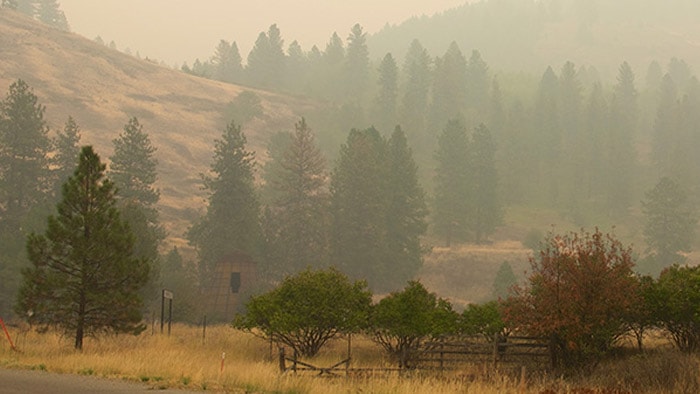Key points
- If your home was affected by a wildfire, do not return home until authorities say it is safe.
- Take steps to protect yourself and your loved ones when returning to your home after a fire.
Stay safe after a wildfire

Continue to check air quality reports.
- Check your local air quality at airnow.gov or on your phone's weather app.
- Take steps to reduce your exposure to smoke. Smoke can stay in the air for days after a wildfire ends.
- Children and people with asthma, COPD, heart disease, diabetes, chronic kidney disease or those who are pregnant need to be especially careful about breathing wildfire smoke.
Protect yourself from ash.
Wildfires leave behind a lot of ash that can irritate your eyes, nose, or skin and cause coughing and other health effects.
- Protect yourself against ash when you clean up. Wear gloves, long-sleeved shirts, long pants, and shoes and socks to protect your skin. Wear goggles to protect your eyes.
- Wash off any ash that gets on your skin or in your eyes or mouth as soon as you can.
- Limit how much ash you breathe in by wearing a NIOSH Approved N95 respirator. A respirator is a mask that fits tightly to your face to filter out ash before you can breathe it in. You must wear a respirator correctly.
- Pay attention to any health symptoms if you or your children have asthma, COPD, heart disease, diabetes, or are pregnant. Get to medical help if you need it.
Can children wear respirators?
Children ages 2 years and older can wear respirators and masks. However, NIOSH Approved respirators do not come in suitable sizes for very young children.
- Choose a respirator or mask that your child can wear properly. If a respirator or mask fits poorly or is uncomfortable, a child might take it off or wear it incorrectly (for example, pulling it down from their nose). This reduces the intended benefits.
- Choose a size that fits over the child's nose and under the chin but does not impair vision.
- Follow the user instructions for the respirator or mask. These instructions may show how to make sure it fits properly.
NIOSH Approved respirators and international respirators may be available in smaller sizes that fit children. However, manufacturers typically design them to be used by adults in workplaces. They may not have been tested for broad use in children.
Drive safely.
- Be alert for broken traffic lights and missing street signs.
- Watch out for trash and debris on the road.
Be careful around damaged buildings or structures.
- Wait to return to buildings during daylight hours, when it is easier to avoid hazards, especially if the electricity is off and you have no lights.
- Learn more: Fighting Wildfires - Hazards During Cleanup Work | NIOSH | CDC
Clean up safely.
- Wear proper safety equipment, avoid carbon monoxide poisoning, and avoid electrical hazards.
- Children should not do any cleanup work.
- Learn more: Clean Up Safely After a Disaster
Protect your emotional well-being
After a wildfire, many people feel different and strong emotions. Finding helpful ways to cope with these feelings, and getting help when you need it, will help you, your family, and your community recover from a disaster.
- Connect with family, friends, and others in your community.
- Take care of yourself and each other and know when and how to seek help.
- Learn more on how to take care of your emotional health after a disaster.
